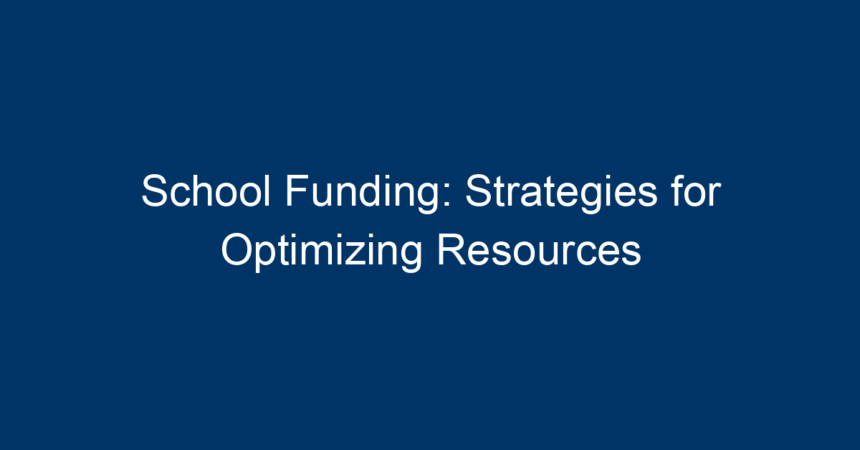In the rapidly evolving landscape of education, the importance of effective school funding cannot be overstated. Schools serve as the bedrock of our communities, nurturing the next generation of leaders, thinkers, and innovators. Yet, many educational institutions grapple with limited resources, leaving educators and administrators scrambling to make ends meet. In this article, we will explore innovative strategies to optimize school funding resources, enabling schools to offer high-quality education and enriching experiences for all students.
Understanding the Landscape of School Funding
Before diving into strategies for optimizing school funding, it’s crucial to grasp the complexities surrounding school finance. Funding can originate from various sources, including:
- Local Taxes: Property taxes often constitute the bulk of funding for public schools, leading to disparities based on local wealth.
- State Allocations: Funding distributed by state governments aims to provide a more equitable resource distribution.
- Federal Grants: Supplemental funding aimed at assisting schools serving low-income populations and addressing specific educational needs.
- Private Contributions: Donations from individuals, businesses, and nonprofits that enhance school funding.
Navigating this multifaceted funding landscape is essential for stakeholders aiming to maximize resources and create impactful educational environments.
Prioritizing Budget Transparency and Accountability
One of the foremost strategies for optimizing school funding involves prioritizing transparency and accountability in budget management. Stakeholders must be aware of how funds are allocated, ensuring that resources are utilized effectively to enhance student outcomes.
Key Actions:
-
Regular Audits: Conduct periodic financial audits to assess spending patterns and identify opportunities for cost-saving measures.
-
Community Engagement: Involve parents, educators, and community members in budget discussions. Transparency fosters trust and collaboration, leading to innovative solutions.
- Data-Driven Decision Making: Utilize data analytics to assess which programs yield the best results. Redirect funds toward initiatives that show proven success in improving student performance.
Exploring Alternative Funding Sources
To augment traditional funding streams, schools should seek alternative funding sources. Diversifying funding can mitigate the impact of budget cuts and amplify available resources.
Potential Sources:
-
Grants and Competitions: Numerous organizations offer grants for innovative educational programs. Research local and federal grant opportunities tailored to your school’s needs.
-
Crowdfunding: Platforms like GoFundMe and DonorsChoose allow schools to present specific projects and solicit donations from the community, thus enhancing classroom resources.
- Partnerships with Local Businesses: Establish mutually beneficial partnerships with local businesses. Businesses can sponsor programs or donate resources in exchange for community goodwill and visibility.
Implementing Cost-Effective Practices
In addition to seeking new funding sources, optimizing existing resources is vital. Schools can implement cost-effective practices that enhance educational delivery without burdening the budget.
Strategies to Consider:
-
Shared Services: Collaborate with neighboring districts to share services, such as transportation, special education programs, or technology support, effectively distributing costs.
-
Resource Allocation: Perform an inventory of existing resources—such as technology, library materials, and sports equipment—and reallocate these resources based on current needs and student interests.
- Professional Development: Invest in ongoing professional development for teachers and staff. Targeted training can enhance teaching effectiveness and, consequently, student achievement, leading to better funding outcomes.
Leveraging Technology for Innovative Learning
As technology continues to reshape education, schools can leverage digital tools to optimize funding through innovative learning solutions. Implementing technology can not only enhance the learning experience but also create efficiencies that save money.
Technological Strategies:
-
Blended Learning: Employ blended learning models that combine online instruction with face-to-face teaching. This approach can reduce costs while providing personalized learning experiences.
-
Open Educational Resources (OER): Utilize freely accessible teaching materials, such as textbooks and lesson plans, to cut down on costly resource purchases.
- Data Management Systems: Implement robust management systems for tracking attendance, assessments, and resource allocation. Such systems can streamline processes and identify areas for improvement.
Fostering Community and Parental Involvement
Strong community and parental involvement can significantly affect school funding and resource optimization. Engaging stakeholders creates a supportive environment and often leads to additional resources.
Engagement Tactics:
-
Volunteer Programs: Encourage parents and community members to volunteer in schools, providing valuable support without incurring additional costs.
-
Fundraising Events: Organize community events like cultural fairs, bake sales, and charity runs to engage families and raise funds for specific school needs.
- Parent-Teacher Associations: Establish or strengthen PTAs that can advocate for better funding and resource allocation within the district.
Navigating Legislation and Policy Changes
Staying informed about legislation and policy changes is crucial for optimizing school funding. Understanding current laws and potential reforms can help school leaders navigate funding challenges more effectively.
Key Actions:
-
Advocacy: Engage with local and state policymakers to advocate for equitable funding policies that benefit all schools, particularly those in underfunded areas.
-
Stay Informed: Join professional organizations that provide updates on educational policy changes, ensuring that your school is always in compliance and can adapt to new funding opportunities.
- Collaboration: Collaborate with other schools and organizations to form coalitions that push for policy changes beneficial to school funding.
Conclusion: Actionable Insights for Optimizing School Funding
As the education landscape continues to evolve, schools must employ innovative strategies to optimize funding and resources. By prioritizing transparency, exploring alternative funding sources, implementing cost-effective practices, leveraging technology, fostering community involvement, and understanding legislative changes, schools can significantly enhance their funding outcomes.
Here are some actionable insights to consider:
- Audit your budget regularly: Identify areas for improvement and reallocate funds wisely.
- Research grant opportunities: Explore grants that align with your school’s programs, applying meticulously to enhance resources.
- Engage parents and the community: Foster connections that lead to increased support and resources.
- Embrace technology: Implement solutions that enhance learning while being cost-effective.
By pursuing these strategies diligently, schools can create thriving educational environments that foster student success and community growth, ultimately leading to a brighter future for everyone involved.




